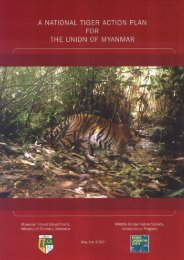Download - Global Tiger Initiative
Download - Global Tiger Initiative
Download - Global Tiger Initiative
Create successful ePaper yourself
Turn your PDF publications into a flip-book with our unique Google optimized e-Paper software.
Law enforcement is also often impeded by a lack of awareness and/or a lack of the political will<br />
necessary to carry out prosecutions. In many of the Snow Leopard range States, environmental<br />
conservation comes especially low on the list of national priorities, in the wake of economic and<br />
political upheaval, for example in the case of Afghanistan and those countries formerly part of<br />
the Soviet Union. In Tajikistan, for instance, laws are reportedly not obeyed and effective<br />
enforcement has been described as generally non-existent (M. Kadamshoev, Pamir Institute of<br />
Biology, in litt., 2002), while in Uzbekistan, law enforcement, especially in the field of nature<br />
protection, is said to be low (E. Kreuzberg-Mukhina, IUCN National Committee/Academy of<br />
Science, Uzbekistan, in litt., 2002). Low rank accorded to species conservation at governmental<br />
level means that wildlife rangers and enforcement personnel will often be poorly equipped and<br />
live on low wages. This in turn can give rise to a fertile breeding ground for corruption, which<br />
plays a considerable role in confounding the efforts of some range States to tackle wildlife crime<br />
effectively, as remuneration for enforcement officials may seem especially paltry compared<br />
with the earnings to be made from trading in Snow Leopard skins and other parts (see Table 3)<br />
(Anon., 1999).<br />
TYPES OF THREAT POSED TO SNOW LEOPARDS<br />
According to the survey of more than 60 Snow Leopard specialists, undertaken by the Snow<br />
Leopard Survival Strategy (see Methods), direct killings of Snow Leopards and loss of their<br />
natural prey base are considered to be the most significant threats to the long-term survival of<br />
the species (McCarthy and Chapron, 2003). The survey results testified to considerable<br />
differences in the type of threat posed between geographic regions. Most notably, a divide<br />
exists between the Himalayan region - Bhutan, India, Nepal and the Tibetan and other parts of<br />
southern China, and the central Asian region - Kazakhstan, Kyrgyzstan, Tajikistan, Uzbekistan<br />
and the Xinjiang Autonomous Region of China. Killings of Snow Leopards in retribution for<br />
livestock depredation were identified as a significant threat in the Himalayan region and in the<br />
Karakoram and Hindu Kush mountains. By contrast, poaching of Snow Leopards for trade was<br />
considered the main threat to the species in the central Asian region and northern range of the<br />
species - in the Chinese Altai mountains and Tien Shan mountains (Xinjiang Autonomous<br />
Province), Mongolia and the Russian Federation (McCarthy and Chapron, 2003).<br />
In many cases, the different types of threat are related and sometimes closely interwoven, which<br />
makes it difficult to identify baseline causes and effects. For example, over-grazing by domestic<br />
livestock may lead to competition with, and eventually loss of, wild ungulates, a major prey<br />
source for Snow Leopards. In turn, such reduction of wild prey often leads Snow Leopards to<br />
prey on domestic livestock, which sets up a negative perception of the cat among herders, who<br />
then become motivated to kill Snow Leopards in retaliation for, or prevention of, attacks on<br />
livestock.<br />
Despite this complexity, it is important that the separate factors influencing threats to Snow<br />
Leopards are identified and carefully assessed to ensure that remedial approaches for reducing<br />
such threats are appropriate.<br />
Loss of natural prey base<br />
Wild ungulates, such as Argali, ibex or Blue Sheep, are adversely affected by over-grazing of<br />
land through increased competition with domestic livestock in parts of the Snow Leopard’s<br />
FADING FOOTPRINTS: the killing and trade of Snow Leopards 19

















